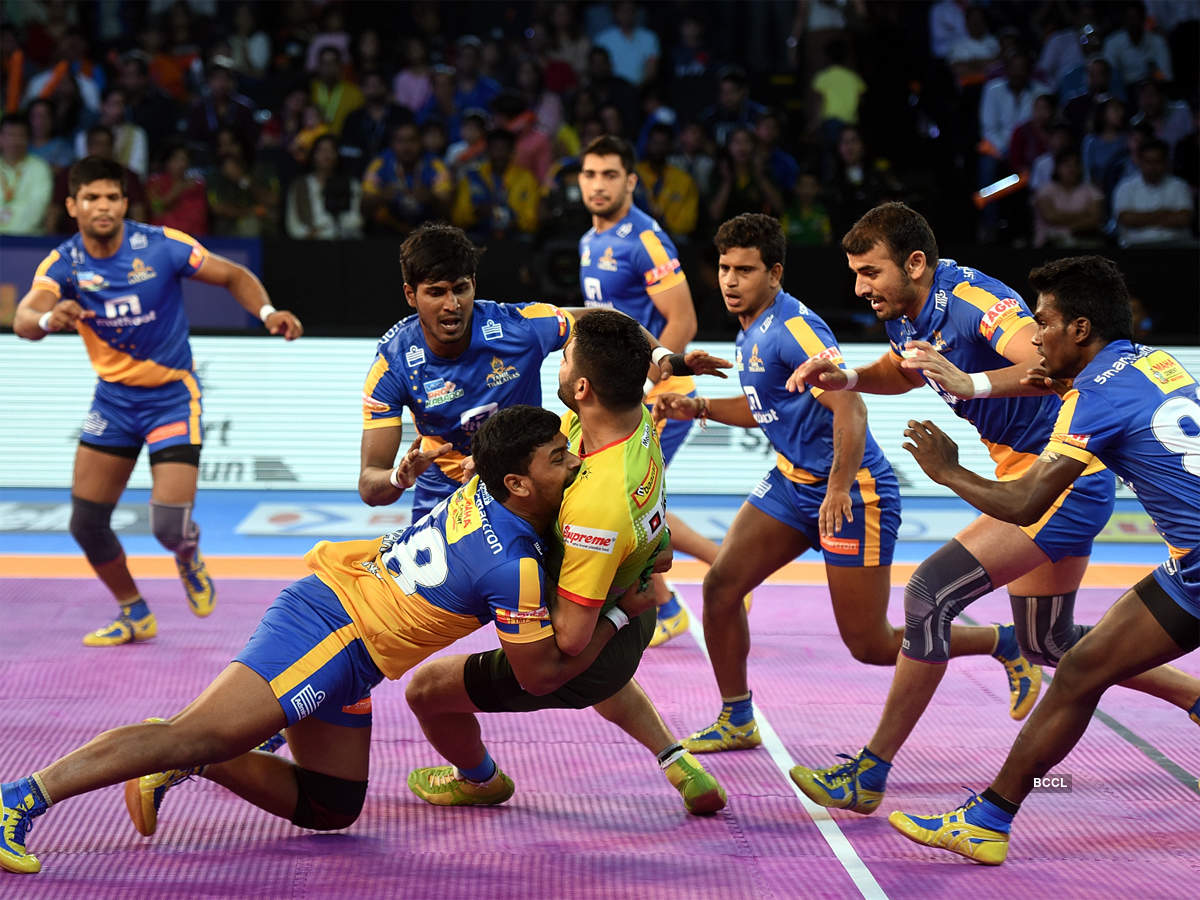
Kabaddi, a dynamic and fast-paced team sport, holds its roots in ancient India and has evolved into a globally recognized game. With a history spanning over 4,000 years, Kabaddi showcases a unique blend of strategy, skill, and physical prowess. In its traditional and modern forms, Kabaddi captivates players and spectators alike with its captivating raids, defensive maneuvers, and the constant ebb and flow between teams. From the bustling Pro Kabaddi League to local tournaments in rural areas, Kabaddi’s popularity continues to soar, making it an integral part of sporting culture. Let’s explore the fundamental rules and captivating aspects that make Kabaddi a thrilling and culturally rich sport.
Ancient Origins: Kabaddi’s roots trace back over 4,000 years to ancient India, making it one of the oldest team sports with a rich cultural heritage. Historically, it was often played to develop strength, speed, and quick reflexes, making it a vital part of physical training in the Indian military.
International Kabaddi Federation: Founded in 2004, the International Kabaddi Federation (IKF) plays a pivotal role in unifying and promoting Kabaddi globally. The establishment of this governing body marked a crucial step in organizing international competitions, fostering camaraderie among Kabaddi-playing nations, and facilitating the growth of the sport beyond its South Asian origins.
Asian Games Debut: Kabaddi’s inclusion in the Asian Games in Beijing in 1990 marked a significant milestone in its journey from a regional sport to a recognized international competition. Since then, Kabaddi has become a regular feature in the Asian Games, contributing to the global recognition and acceptance of the sport.
First World Cup: The inaugural Kabaddi World Cup in 2004, hosted in Mumbai, India, showcased the sport’s global appeal. Bringing together teams from various countries, the tournament set the stage for future international competitions, elevating Kabaddi to a world-class sporting event.
Seven Players on Each Team: Traditional Kabaddi involves two teams, each consisting of seven players. This unique configuration emphasizes teamwork, strategy, and individual skill, creating a dynamic interplay between raiders and defenders within the defined playing area.
Playing Area Dimensions: A standard Kabaddi playing area measures 13 meters by 10 meters, providing a confined yet strategically dynamic space for the athletes. This carefully defined space is essential for maintaining the fast-paced and intense nature of Kabaddi matches.
Raids and Defenders: Kabaddi’s essence lies in the intricate interplay between raiders and defenders. A raider’s mission is to infiltrate the opponent’s half, tag defenders, and return safely, while defenders must use strategy and teamwork to prevent the raiders from scoring points.
Raider’s Chant: The requirement for a raider to continuously chant “Kabaddi, Kabaddi” without taking a breath while on the opponent’s side adds a unique and challenging aspect to the sport. This ritual not only serves as an audible indicator of the raider’s presence but also tests their endurance and mental focus during a raid.
Touch Points: Points in Kabaddi are scored through touch points, where raiders touch defenders and return safely to their side. This scoring mechanism places emphasis on the agility and evasive skills of raiders, making each raid a dynamic and suspenseful moment in the game.
Do-or-Die Raid: The concept of a do-or-die raid, triggered when a raider fails to score in three successive raids, adds an intriguing dimension to Kabaddi. It introduces strategic considerations for both teams, as the raider faces the challenge of scoring to avoid getting out, while defenders aim to capitalize on the pressure to secure an advantageous position in the game.
Women’s Kabaddi World Cup: The introduction of the Women’s Kabaddi World Cup in 2012 marked a pivotal moment for the recognition and empowerment of women in the sport. This initiative provided female athletes with a global platform to showcase their skills, fostering gender equality and expanding the reach of Kabaddi to a broader audience.
Highest Raid Points in a Single Match: Anup Kumar’s record for the highest raid points in a single match, with an impressive 16 points, exemplifies the individual brilliance that can shine in Kabaddi. His exceptional performance showcased the potential for players to make a significant impact on the outcome of a match through skill and strategic prowess.
Pro Kabaddi League (PKL): Launched in 2014, the Pro Kabaddi League has played a transformative role in elevating Kabaddi’s status as a professional sport. The league’s success has not only provided players with lucrative opportunities but has also contributed to the commercialization and globalization of Kabaddi, attracting a diverse fan base.
Most Expensive Kabaddi Player: Monu Goyat’s historic ₹1.51 crore ($215,000) deal in 2018 with Haryana Steelers made him the most expensive player in the history of the Pro Kabaddi League. This landmark contract underscored the growing financial significance of Kabaddi and the increasing value placed on top-tier players in the league.
Longest Unbeaten Streak: Iran’s national Kabaddi team’s remarkable unbeaten streak in international competitions reflects the country’s dominance in the sport. This achievement not only showcases the team’s exceptional skills but also underscores the consistent high-level performance that has made them a force to be reckoned with on the global Kabaddi stage.
Asian Kabaddi Championship: Established in 1980, the Asian Kabaddi Championship has been a cornerstone of regional competition, fostering camaraderie and healthy rivalry among Asian nations. The championship serves as a vital platform for teams to test their mettle and showcase the evolving landscape of Kabaddi in the continent.
Kabaddi at the Olympics: Despite its popularity, Kabaddi has yet to secure a spot in the Olympic Games as of my last knowledge update in January 2022. The ongoing efforts by Kabaddi enthusiasts and governing bodies to gain Olympic recognition highlight the sport’s global ambitions and its potential to reach new heights.
Youngest Kabaddi Player: While there isn’t a specific age limit for Kabaddi players, the sport’s professional leagues typically feature young talents, with players often making their debut in their late teens. This emphasis on youth involvement ensures a continuous influx of fresh talent and contributes to the sport’s dynamic and energetic nature.
Oldest Kabaddi Player: Kabaddi’s lack of a specific age limit allows players to continue competing as long as they remain physically fit. This flexibility has led to instances of seasoned players showcasing their skills, demonstrating that age is not necessarily a barrier to active participation in the sport.
Kabaddi in Popular Culture: Kabaddi’s integration into popular culture, as seen in Bollywood films like “Okkadu” and “Kabaddi Kabaddi,” has played a crucial role in boosting the sport’s visibility. These cinematic portrayals not only entertain audiences but also contribute to Kabaddi’s cultural significance and its resonance beyond the sports arena.
Kabaddi’s Spread to Non-Asian Countries: Kabaddi’s growing popularity in non-Asian countries, with teams from places like Argentina and the United States participating in international competitions, underscores the sport’s potential to transcend cultural boundaries. This global embrace of Kabaddi signifies its evolving status as a sport with a universal appeal and the capacity to unite players from diverse backgrounds.
Kabaddi Coaching Institutes: The establishment of Kabaddi coaching institutes and academies in India has been instrumental in nurturing and refining the skills of aspiring players. These institutions provide structured training programs, coaching expertise, and state-of-the-art facilities, contributing to the development of a new generation of Kabaddi athletes.
Highest Attendance in a Kabaddi Match: The Pro Kabaddi League, known for its electrifying atmosphere, has witnessed matches with record-breaking attendance. These instances reflect the league’s success in engaging fans and creating a vibrant sporting culture around Kabaddi, both in India and globally.
Kabaddi in Schools: Kabaddi’s inclusion in school sports programs across India and other countries has played a crucial role in fostering grassroots development. By introducing the sport at an early age, schools contribute to the cultivation of talent and the promotion of a healthy and active lifestyle among students.
Kabaddi in Rural Tournaments: Kabaddi’s enduring popularity in rural areas, where numerous local tournaments are held throughout the year, exemplifies the sport’s grassroots connection. These tournaments not only provide a platform for local talent but also serve as cultural events, bringing communities together and preserving Kabaddi’s traditional significance in various regions. The rural enthusiasm for Kabaddi emphasizes its accessibility and appeal across diverse settings, contributing to its resilience and continued growth.









